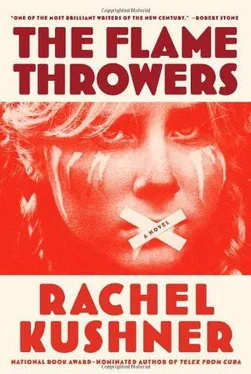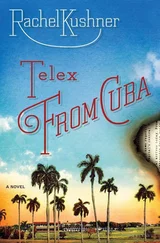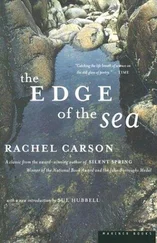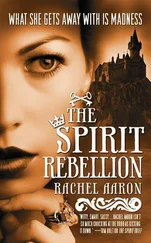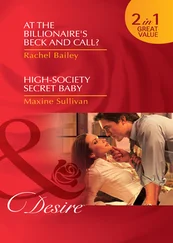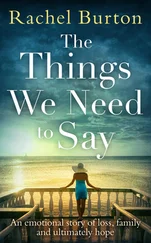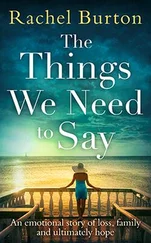We were on Lafayette, outside the Trust E Coffee Shop.
“I can’t believe it,” I said excitedly. “Where is he? Do you know what he’s up to?”
She tugged the foil apron from a new pack of North Pole cigarettes and tossed it on the sidewalk. I watched it skitter.
“I don’t know,” she said. “He’s around. He’s on the scene.”
The wind blew the discarded foil sideways.
“What scene?” I asked, and then Giddle became cryptic, like, if you don’t already know, I can’t spell it out. That was when I first sensed, but then almost as quickly suppressed, something about Giddle, which was that there might be reason to doubt everything she said.
* * *
I told this friend of Nadine and Thurman’s that I was from Nevada and he started calling me Reno. It was a nice word, he said, like the name of a Roman god or goddess. Juno. Or Nero. Reno. I told him it was on the neon archway into town, four big red letters, R-E-N-O. I made a film about it, I said. I set up a tripod and filmed cars as they came to a stop at the traffic light under the archway.
“Spiritual America,” he said. “That’s Thurman’s thing, too. Diner coffee. Unflushed toilets. Salesmen. Shopping carts. He’s about to become famous. He’s having a show at the Museum of Modern Art.”
Thurman was not listening to us. He was nibbling on Nadine’s ear.
The friend said, “He’s a great artist.”
“And what are you?” I asked.
“I turn the hands on the big clock in the lobby of the Time-Life Building. Twice a year it has to be reset, to daylight savings and then back to standard time. They call me. It’s a very specialized job. If you push too hard, you can bend the hands of the clock.”
There were tacit rules with these people, and all the people like them I later met: You weren’t supposed to ask basic questions. “What do you do?” “Where are you from?” “What kind of art do you make?” Because I understood he was an artist, but you weren’t allowed to ask that. Not even “What is your name?” You pretended you knew, or didn’t need to know. Asking an obvious question, even if there were no obvious answer, was a way of indicating to them that they should jettison you as soon as they could.
“I was in Nevada once,” he said. “To see something a guy I knew made, the Spiral Jetty . The artist, Smithson, had just died. He was a friend, or something like one. Actually, he was an asshole. A sci-fi turkey, but brilliant—”
I said excitedly that I’d been there, too, that I had read his obituary, I knew who he was, but he didn’t seem to think it was a remarkable coincidence.
“He had a hilarious riff about the ‘real authentic West,’ pretending he’s Billy Al Bengston, you know, gearhead who makes paintings, and he’d say, ‘You New York artists need to stop thinking and feel . You’re always trying to make concepts, systems. It’s bullshit. I was out there chrome-plating my motorcycle and you’re, like, in skyscrapers, reading books.’ Smithson was a genius. There are two great artists of my generation,” he said. “Smithson is one and my friend Sammy is the other.”
“What does he make?”
“Nothing. He makes nothing. He’s living outside this year. He doesn’t enter any structures. Right now he’s camped in a park in Little Italy. He had been out in the Bronx sleeping on a construction scaffold and they were shooting at him.”
There was another man, besides Henri-Jean with his pole, who was often in my little park at Mulberry and Spring. He slept there sometimes and I figured he was homeless but he didn’t quite look it, this young Asian man with shoulder-length hair. There was something too careful and precise about him. I asked if his friend Sammy was Asian and he nodded and said Taiwanese, and I told him I thought I’d seen his friend. He said Sammy had come to New York as a stowaway on a merchant vessel, and that whenever this came up people assumed it was an art project, a performance he had done, and Sammy would have to explain the obvious, that he did it like millions of others, to come to New York. To be an American. And people would laugh as if there were a deep irony under the words.
“We have a bond, Sammy and I,” the friend said. “In having spent a lot of time on boats. In having been delivered from that into a realm where everyone thinks we’re kidding. But it’s the other way around. Life is kidding us.”
I pictured a shore at night. Dark water like the edge of a curtain. A nighttime sea where he and his friend Sammy had both spent time.
* * *
At some point Thurman and Nadine decided we were going to another bar. “You’re coming?” I asked the friend. I sensed his hesitation before he nodded sure. Under it, Why not? There’s nothing better to do. He left his motorcycle in front of the bar because it turned out Thurman had a car. Not just a car but a car and driver — a mid-1950s black and brushed-metal Cadillac Eldorado with a chauffeur who looked about fourteen years old, in a formal driver’s jacket that was several sizes too large, and white gloves, also too large. I thought of the drivers on Mulberry. I said it was like Little Italy on a Sunday but no one heard me or they didn’t care.
We piled into the car with drinks in our hands. Nadine had picked hers up and carried it toward the bar’s exit, and following behind, I thought, Yes, of course. This is how it’s done. Thurman paid our tab, and I was with them, in a Cadillac Eldorado, heavy rocks glasses in our hands, damp cocktail napkins underneath, the ice in our glasses ta-tinking as the car turned slow corners, honking so people would get out of our way, because we were important in that car, me on their handsome friend’s lap, our drinks going ta- tink, ta- tink .
“This is my favorite,” the friend said, pulling a leather datebook from a pocket in the door. “It actually comes with the car: the 1957 Brougham’s own datebook. And this,” he said, pulling out a perfume bottle from a little cubby in the armrest. “The Lanvin cologne atomizer with Arpège perfume. You could order this stuff at the GM dealership when these models were new. Thurman, what else is this thing loaded with?”
“Beats me,” Thurman said. “Blossom was willed the car. It belonged to Lady von Doyle.”
This Blossom had been mentioned several times now. I didn’t ask who she was, who any of the people they mentioned were. I wanted to study the way they spoke. Not interrupt the flow, be the person they had to stop and explain things to.
Their friend reached back into the armrest and retrieved a leather-bound flask with a big GM symbol on it, opened it, and sniffed.
“Scotch,” he said. “This is true post-Calvinist delirium. Like the Jews at Sammy’s Roumanian, eating steaks that hang off the plates, a big pitcher of chicken schmaltz on the table. It’s all about never going hungry again.”
He poured from the flask into our glasses. I felt the presence of his body as he leaned.
“I think Lady von Doyle was Jewish,” Nadine said. “Thurman, wasn’t she Jewish?”
The friend said that seemed about right, for a Jew to drive a Cadillac. “In a sense,” he said, “there is simply this axis of General Motors and Volkswagen. I myself have a VW Bug, a car we associate with Eugene McCarthy and flower power and not with Hitler, who created it. The VW doesn’t make you think of Hitler and genocide. It’s a breast on wheels, a puffy little dream. The Cadillac, now, that’s a different dream. Of the two, you’d expect the Cadillac would represent some unspeakable horror, crimes against humanity. Look, here’s the Brougham powder puff. The lipstick case. The pill dispenser. The Evans pocket mirror. All that’s missing is the Tiffany cocaine vial and a chrome-plated.44 Magnum.”
Читать дальше
